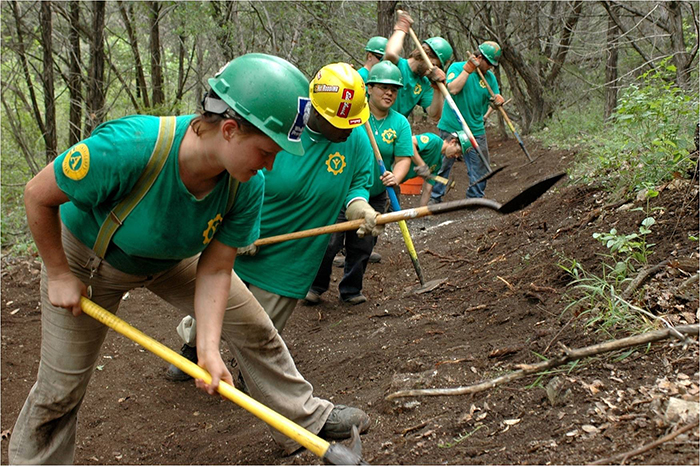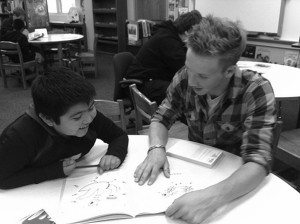 With Thanksgiving behind us and Christmas right around the corner, it’s the time of year when people start finding the time and motivation to give back to their communities—but engaging with your community shouldn’t just be something you do during your break.
With Thanksgiving behind us and Christmas right around the corner, it’s the time of year when people start finding the time and motivation to give back to their communities—but engaging with your community shouldn’t just be something you do during your break.
Volunteering is far more beneficial if you’re able to make a connection with the work you’re doing in your community and the work you’re doing in class. This type of learning is called service learning and is best described as a balance of community service with academic reflection, according to David Bodary.
Bodary, Communication Professor and Coordinator for The Service Learning Program at Sinclair, defines service learning as “a pedagogy, or teaching approach, that’s used to try and help students connect between course related learning and the application of that learning outside of the college environment, so in the real world if you think of it that way.”
It’s a very pragmatic approach to learning that believes in taking action, as well as learning from books. Once students can see the usage of academic material in a real life situation, the learning becomes reinforced and much more long-term—the main idea is to mix community service with learning.
So for instance a dietetic student, someone who works with food and nutrition, might be set up to work with the House of Bread or a food bank. That way they can take the skills they’re learning from class and find ways to apply it during their service.
Another example would be a physical therapy student helping with the Special Olympics. The best part of service learning is that participants are killing two birds with one stone; while students are getting the opportunity to explore the career path that their class is heading towards, the community also fills its need for volunteers and gets the help it needs to further better itself.
 The activities that service learning provide students with are called “service projects.” Classes that require you to do them aim for about 10 hours a semester, so the commitment isn’t full-time, and the benefits of these projects aren’t just about learning; you’re also getting to work with people in your field. This could lead to a co-op or paid internship, and from that, it could even lead to a job right after graduation.
The activities that service learning provide students with are called “service projects.” Classes that require you to do them aim for about 10 hours a semester, so the commitment isn’t full-time, and the benefits of these projects aren’t just about learning; you’re also getting to work with people in your field. This could lead to a co-op or paid internship, and from that, it could even lead to a job right after graduation.
In a sense it’s a step between the classroom and an internship; you’re not quite getting the full paid experience of a job, but you are in a situation that will simulate it well to give you a feel of what it will be like. The important thing to remember is that it is an engaged activity.
While volunteering during the winter break might be great for the community, you aren’t getting the educational reflection that is such a critical part of service learning. The best way to go about it is to participate, while also attending classes, that way you can make the connection between book material and the real life situation.
While the academic learning is important, another great part of service learning is the altruism, or a desire to help people, that comes with it. Bodary shared a story about a group of paralegal students who saw an issue with bedbugs in local subsidized housing and felt that it wasn’t a way someone should be living.
The engagement with the community brought them to take action and work with a group of volunteer lawyers to file a suit and have the landlord address the problem. This brought about a big change in living conditions for the people, and more than likely made their lives a little better.
It’s actions like that which change our community for the better, according to Bodary.
“I think when a person steps out into their community and volunteers through service learning or any part, that you can’t help but become more aware and better understand ‘what are those community needs?’ and ‘what are those community resources to meet those needs?’” Bodary said. “[I think,] engage in that community and make it what I want it to become.”
A study done at the Higher Education Research Institute of the University of California suggests that service learning is highly effective for four main reasons: it increases a sense of personal growth or change, it increases your awareness of the real world, it gives you insight into your own personal values and it increases your connection with your classroom studies.
So what are some ways that you can participate in service learning? Some of you might already be a part of it. A small number of professors at Sinclair implement it as a mandatory part of their curriculum; such as, the American Sign Language department. For others, it’s offered as part of an honors option for certain classes. The best way to find out is to ask your professors.
With Spring semester coming up, it’s vital that students start communicating with their teachers early on in the class and find out if there’s a service learning option. Bodary said his main focus is to help connect the dots between the community and the faculty or the students and to try to help make sure that they’re making good fits.
Bodary offers his services to students who simply just want to find volunteer options that would work well with their academic focus. For more information about the Service Learning Program email service.learning@sinclair.edu.
Nick Felts
Staff Writer

